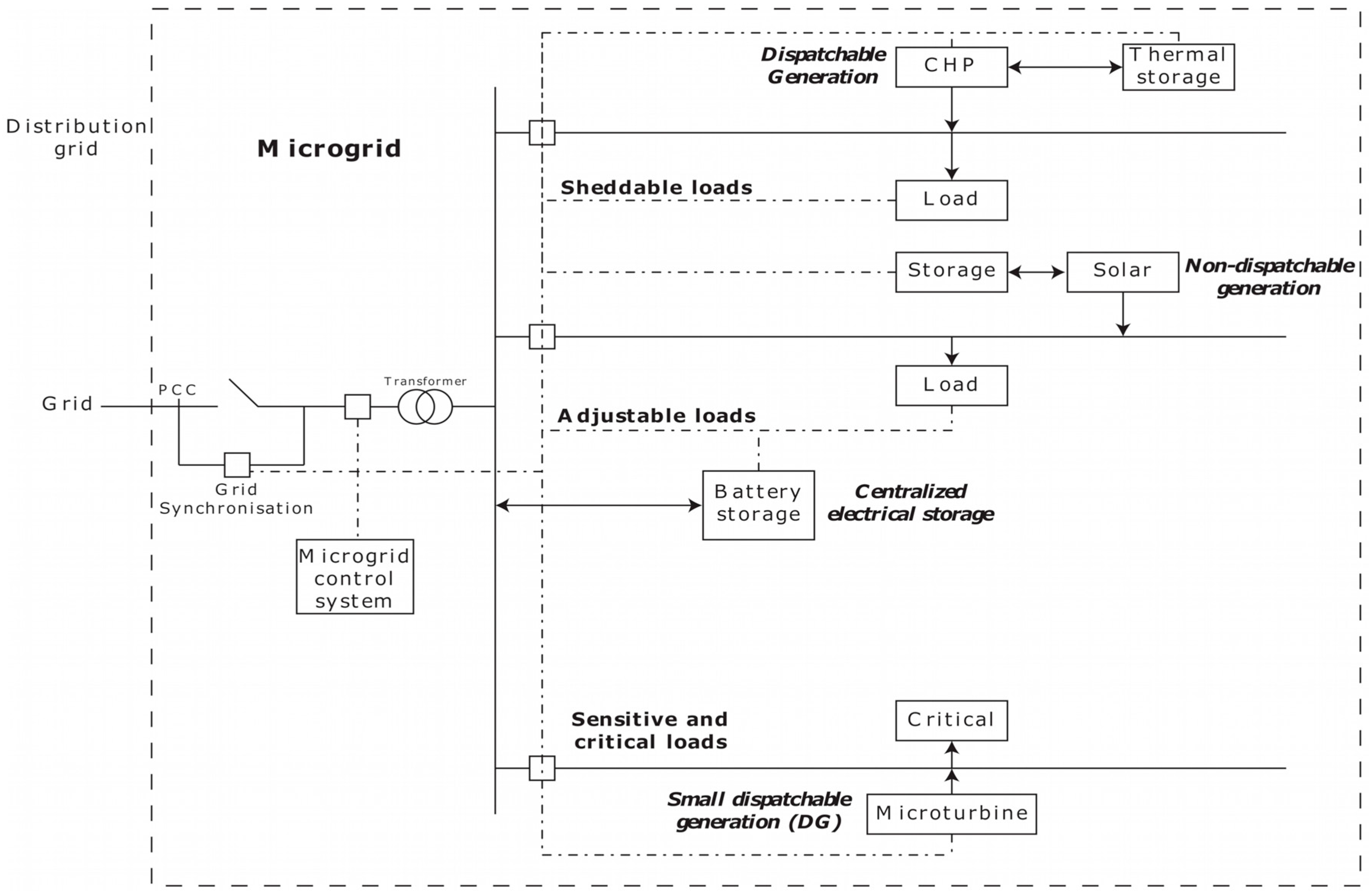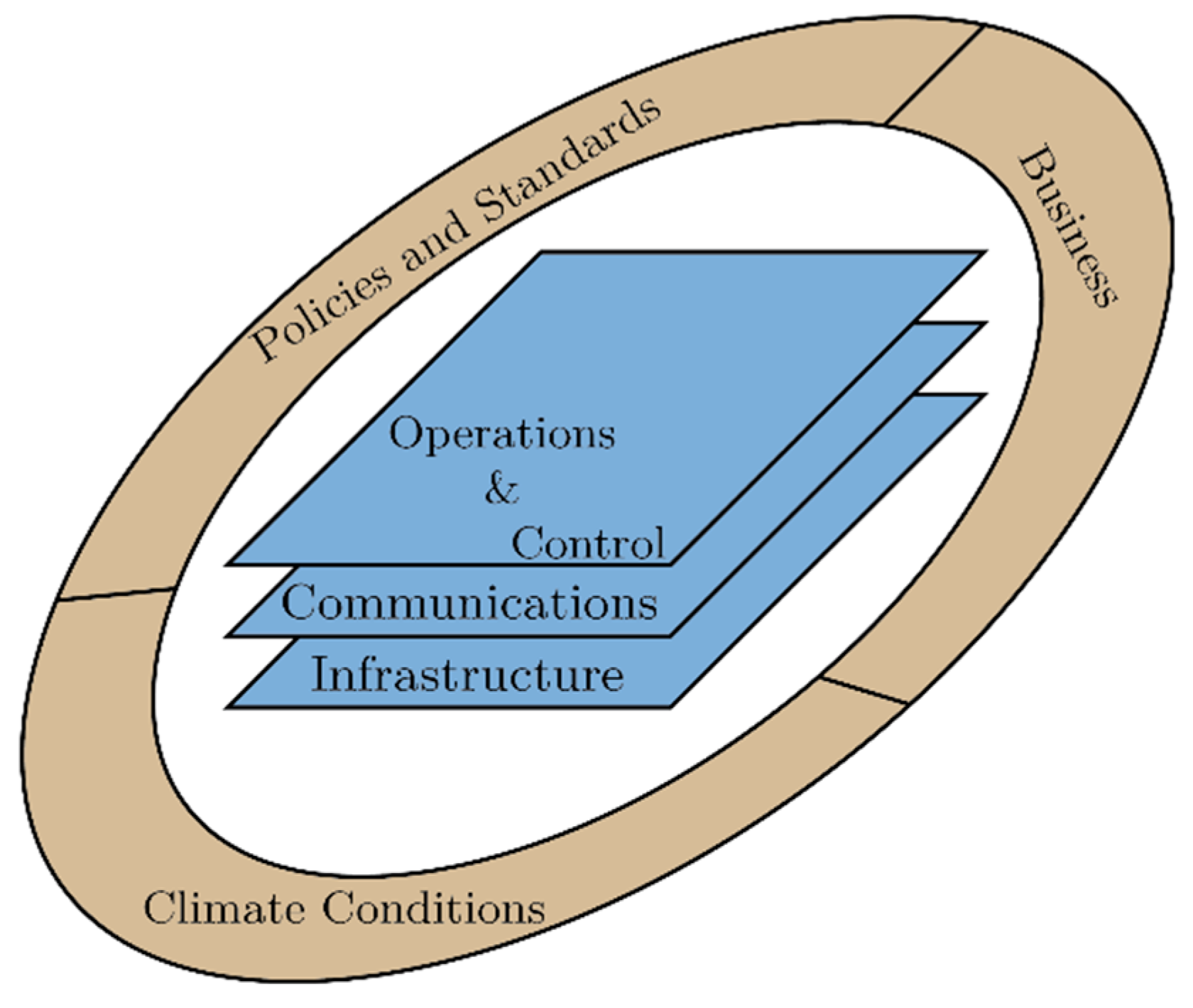Definitions
There are many definitions about what a microgrid is [6–8,16–23]. All of them are extremely similar with little variance. There are three common factors which they all share: (a) islanded and grid connected functionalities; (b) clearly defined electrical boundaries; and (c) a control entity able to manage the energy resources along the loads. A microgrid structure concept similar to the one proposed in [7] and can be seen in Figure 1.
The concept of a microgrid was not the same from the beginning and, according to [9], a microgrid was seen from a very broad perspective in the very beginning as a power subsystem gathering generation and loads. After a time, it was established that microgrids worked on a distribution level, and later on, their islanding capability was finally presented. Even though nowadays the concept of a microgrid is not universally accepted as we have seen, in [24] the authors go even further and imply that there are also differences depending on the region of the world. According to them, the US perspective is that a microgrid can supply both heat and power, whereas in the EU approach, the heat supply is not usually considered.
Apart from microgrids built on islands or remote areas, the concept of a microgrid implies being connected to a stronger grid. Actually, many of its benefits come along with this capacity of connection and disconnection. For the purpose of islanded functionality, it is adequate for the microgrid to have an installed generation capacity exceeding the maximum load. In any other case, some loads may be sacrificed when the microgrid operates disconnected from the main grid.
Within its boundaries, the microgrid may integrate generation and responsive loads as well as storage systems. It should be seen as a single controllable entity by the main grid, which is a similar perspective that virtual power plants have [25,26]. The main difference between them is the islanded capability. In many cases, the microgrid is located at a LV level with some exceptions where it can have a medium voltage (MV). Some authors also make distinctions considering the power supplied to the microgrid, clustering them as picogrids or nanogrids [24].

Figure 1. AC microgrid structure and components example.
The benefits of microgrids are very similar in both industrial documents and scientific research. All of them imply that MGs are reliable and efficient [8,16,27–32]. In almost all analysed publications, reliability and efficiency are described from different perspectives. The essence of energy reliability is related with one of the main characteristics of microgrids: its islanded functionality. The efficiency, in contrast, is the result of many factors, but the most repeated one is the characteristic of having the generation close to the demand. However, microgrids have many more benefits. For instance, [16,27] conclude that a microgrid is also a system independent from fuel variable prices since it is an adequate environment to implement renewable generation sources. The ability of microgrids to give access to remote areas where the main grid cannot reach, mainly due to excessive costs, is also pointed out. More renewable sources have the benefit of reducing harmful emissions as a consequence as it is denoted by [8]. In that same document, the most extensive study about the benefits of microgrids is developed. It is not only divided into direct or indirect benefits, but also relates them to the microgrid stakeholders. The security benefit is outlined in [28,29]. It is related with resiliency, but it is more focused on the detection and prevention of external disruptions, which is a subject of study in smart grids. The job creation benefit is explained by [16] and is related with local jobs, not only in maintenance. Benefits usually imply economic advantages, and some of them are studied in [8,33,34].
Despite MGs having many benefits, some of their main characteristics need to be further analysed. In [31], the main barriers for a wider adoption of MGs are shown. The main enablers to avoid the proposed barriers are also discussed. Both topics are evaluated with different utility acceptance levels. For instance, when changing from grid connected to islanded, many security and economic issues may come to mind. The concern of utility regarding connection tariffs, among some others, are shown in [28]. In this manuscript, the relationship among the different stakeholders and their main goals are discussed. According to them, regulatory entities have a key role in the relationship among MG agents. Regarding technical and security features, general interconnection requirements are established in [35]. Technical issues related with intentional and unintentional islanding are also treated. Other manuscripts like [36] also analyse the interconnection requirements from the technical control perspective.
Microgrid Functional Structures
There are different perspectives on how to differentiate the microgrid functional structure. Most articles focus on just one of the structures, but sometimes more are handled [9,17,37–39]. To clearly classify and asses the information of these structures, a layer-based approach can be followed.
Some authors already used a layer-based microgrid model to present a clear division of what functions this power system has. Martin-Martínez adapted in [24] the layer-based concept of CEN-CENELEC-ETSI into a microgrid perspective [40]. Maitra in [41] also chose a similar visualization of the microgrid and used it from a controller point-of-view. Due to its simplicity and clarity, this paper brings back this concept and adds some different conditions to explain and develop this article.
Martin-Martínez et al. [24] differentiates a microgrid in five layers. Those layers are regulatory framework, business models, intelligence, communications, and infrastructure. A disaggregation is also made into various levels (MG, nanogrid, and picogrid) according to the size of the subset of the grid. In [32], the technology in a MG is also divided into five layers. From Layer 0 to Layer 3 as he proposes would differentiate the physical equipment, the system protection and control, the automation and control, the monitoring, and scheduling. Then, Layer 4, optimization and dispatch, with the energy market, grid, and transactive operations as the last layer.
In this manuscript six different layers have been differentiated. Three of them are considered to have interactions mainly with external conditions to the MG. These are called, external layers and can be differentiated into policies and standards, business, and climate conditions. Most of their features depend on the environment and the location where the MG has been built. In contrast, the other three are called internal layers and have mainly interactions between other layers. These are separated into infrastructure, communications, as well as operation and control. In Figure 2 the six layers are represented. The internal layers are the inner ones, while the external layers are the outer ones.

Figure 2. Microgrid layer structure.
Despite it mainly being used in companies from a project management perspective, conducting an analysis of the environment and identifying the relations and risks associated is a key factor of success in any kind of project [42–44]. A microgrid, as a project, should consider all of this, and thus a different approach is followed in the layer concept within this article, where the external conditions to the microgrid are analysed to see the interactions among all the layers. Within the following section, most of the layers will be reviewed.
 Encyclopedia
Encyclopedia
